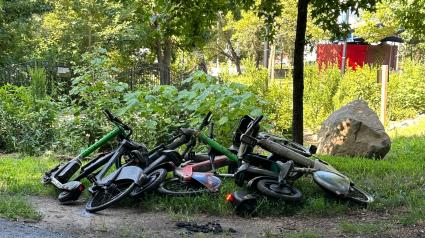The sun filters through a bridge over Starlight Park, casting a golden shimmer on the Bronx River. Below the surface, schools of juvenile herring fill the water — small, silvery signs of the river’s fragile recovery. But along the shoreline, the scene is different: half-submerged e-bikes and e-scooters pock the river’s bank.
“These juvenile fish are a symbol of life returning to the river,” says Siddhartha Sánchez, executive director of the Bronx River Alliance, whose members clean the river and its banks of debris. “But the juxtaposition is disturbing: These discarded scooters carry lithium, heavy metals, toxic materials. They’re a hazard not just to the ecosystem, but to our staff, too. These electric batteries can explode if damaged or mishandled.”
The Alliance started keeping records of the problem last July, and since then, its workers have pulled 410 e-scooters and e-bikes out of the river. But workers have been finding vehicles in large numbers since 2021 when the Department of Transportation’s Shared E-Scooter Program began in the Bronx.
This April, a YouTuber with Two Feet Outdoors explored the river by kayak, but first had to remove e-scooters from Veo, Lime, and Bird – the three companies that participate in the city’s e-scooter program – and Citi Bikes:
“I think people just toss them right off the bridge,” he said at one point on his tour.
Under the DOT’s program each e-scooter company is allowed up to 2,000 vehicles for a total of 6,000. The pilot was deemed a resounding success, with over 86,000 rider accounts and an average of 2,800 trips per day, according to a DOT report.
But the report did not mention the river dumping, which threatens to overwhelm the organization’s limited resources.
“We don’t have the luxury that other conservancies and parks partners have to receive funding from the local business community and the immediate ZIP code surrounding the park,” said Sánchez. “It’s a tremendous strain on our resources. We spend a significant amount of energy pulling garbage out of the river, but this is another level of garbage in that it’s toxic, dangerous, heavy, and very labor intensive.”

Currently, the Bronx River Alliance is the only entity that can remove the vehicles because of its stewardship agreement with the Parks Department (under city rules, the companies cannot collect their own devices). Sánchez said he wants the Alliance to be able to work with the four companies that operate micro mobility programs in the area, Citi Bike on the west side of the river and to the east, Bird, Lime, and Veo.
“We’re just beginning to go public about the issue, and we’re looking to work with the companies and be part of the solution with them. We want these micro mobility options for our neighborhood,” said Sánchez.
The companies are no stranger to this issue; it’s been a problem in other cities as well. Lime, which operates in 280 cities worldwide, says it has worked hard to solve the problem in the Bronx.
“We’ve used our expertise from cities around the world to effectively address this issue in the Bronx, including supporting the Bronx River Alliance for several years, and we would of course be happy to partner with them again in the future,” said Nicole Yearwood, senior manager of government relations at Lime, in an emailed statement.
The Alliance says it has pulled 71 Lime scooters from the river since July 2023, but Lime says it has lost only seven scooters to river dumping this year, evidence that vandalism is more common early on in implementation.
But volunteers with the Alliance pulled 11 vehicles out in one afternoon last week.
A Citi Bike rep told Streetsblog that its docked system helps ensure that bikes don’t leave the system, since a bike that is left undocked for over 24 hours begins to rack up fines.
Last year, Veo, one of the three companies involved in the pilot, suspended some of its service near the river because of the dumping problem.
“Our field team reports that they have seen a decrease in vandalism and vehicles ending up in the river since we made changes to our geofence to address this issue,” Paige Miller, a spokesperson for Veo, told Streetsblog in an emailed statement.
Bird did not respond to Streetsblog’s request for comment.

All three scooter companies count the Bronx River Greenway and the parks lining the river, controlled by the Bronx River Alliance, as sort of “no fly zones.” Scooters stop working when they enter these areas and need to be walked out of the zone to start up again.
Sánchez said that the geo-mapping used by the three scooter companies causes frustration, which he thinks can lead to the dumping.
“There was a lot of dumping in the river, so parks were cut out of the geography that these vehicles could travel in. That may be part of the frustration some clients are feeling now,” said Sánchez. “I tried [the scooters] with my daughter last month, we couldn’t get close to the ferry, we couldn’t get close to Garrison Park, we had to go over by the highway and down Bronx River Avenue. You can’t ride the greenway. The safer places that you want users have become an issue because of the river.”
The Department of Transportation did not respond to Streetsblog’s request for comment.

